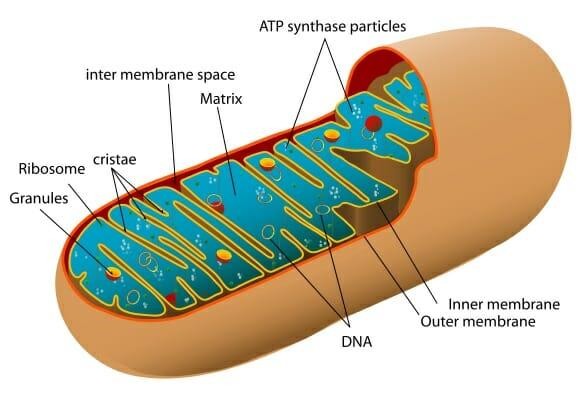
The more involved I become with stem cells and the field of Regenerative Medicine the more convinced I become of the importance of the mitochondria. Many of us in clinical medicine seem to brush over mitochondria. We now realize that many diseases are related in some way to deficiencies of the mitochondria. Success in stem cell procedures may depend on the health of the mitochondria. The above illustration shows the structure of the mitochondria. Mitochondria are rod-shaped organelles that can be considered the power generators of the cell, converting oxygen and nutrients into adenosine triphosphate (ATP). ATP is the chemical energy "currency" of the cell that powers the cell's metabolic activities. Mitochondria are often referred to as the powerhouses of the cell. They help turn the energy we take from food into energy that the cell can use. But, there is more to mitochondria than energy production. In fact, only about 3 percent of the genes needed to make a mitochondrion go into its energy production equipment. The vast majority are involved in other jobs that are specific to the cell type where they are found. Here is another illustration of the inner workings of the mitochondria
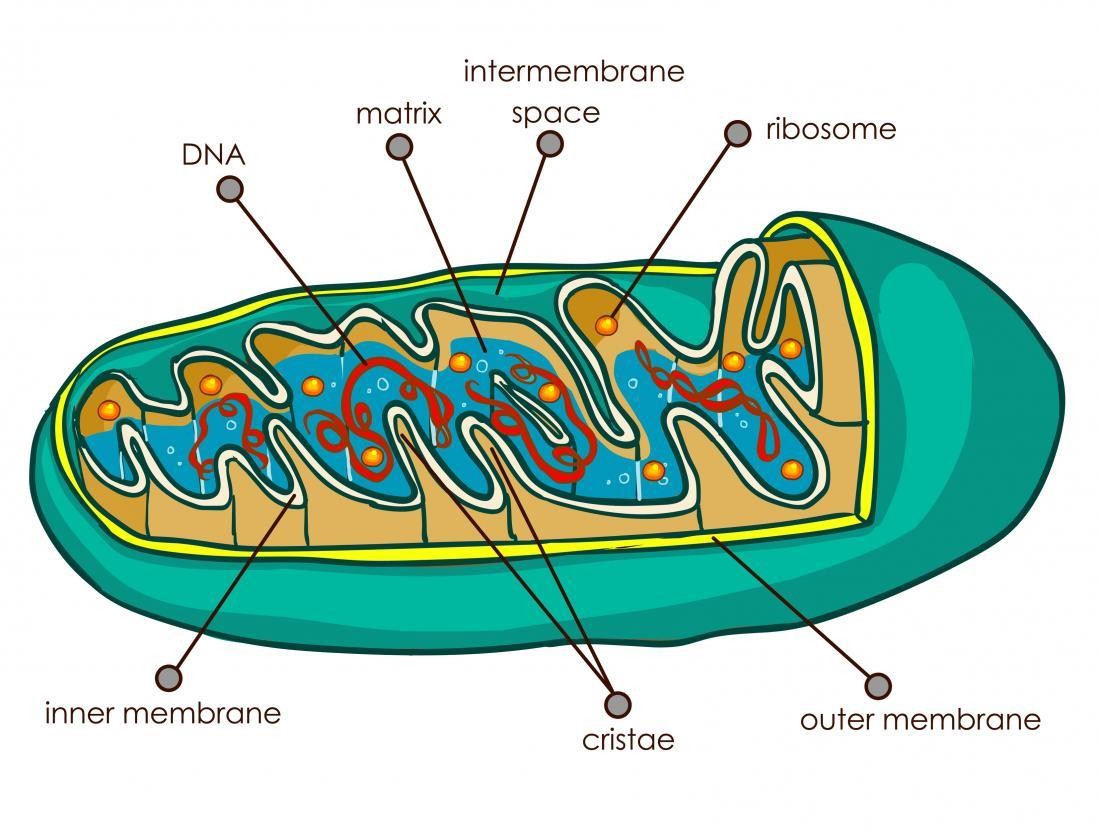
The mitochondria have two membranes, an outer one and an inner one. Each membrane has different functions. The Outer membrane allows small molecules can pass freely through the outer membrane. This outer portion includes proteins called porins, which form channels that allow proteins to cross. Most cellular stress responses converge on the mitochondria. Consequently, the mitochondria must rapidly respond to maintain cellular homeostasis and physiological demands by fine-tuning a plethora of mitochondria-associated processes. The outer mitochondrial membrane proteins are central to mediating mitochondrial dynamics, coupled with continuous fission and fusion. These proteins also have vital roles in controlling mitochondrial quality. When cellular components like mitochondria become damaged or defective, they can be “recycled” by cells through a process called autophagy, which literally means “self-eating.” When mitochondria are degraded by autophagy, the process is specifically referred to as mitophagy. Mitophagy
often occurs in defective mitochondria following damage or stress. This is actually one of the important aspects of aging. As we age, mitophagy will diminish resulting in increased damaged mitochondria. This has a snowball effect in that it leads to increased reactive oxygen species (ROS), decreased bioenergetics, and many age-related diseases. Mitochondrial damage may be the seminal event in many different diseases. If we increase mitophagy we will slow down aging. The following illustration shows the consequences of accumulated mitochondrial damage.
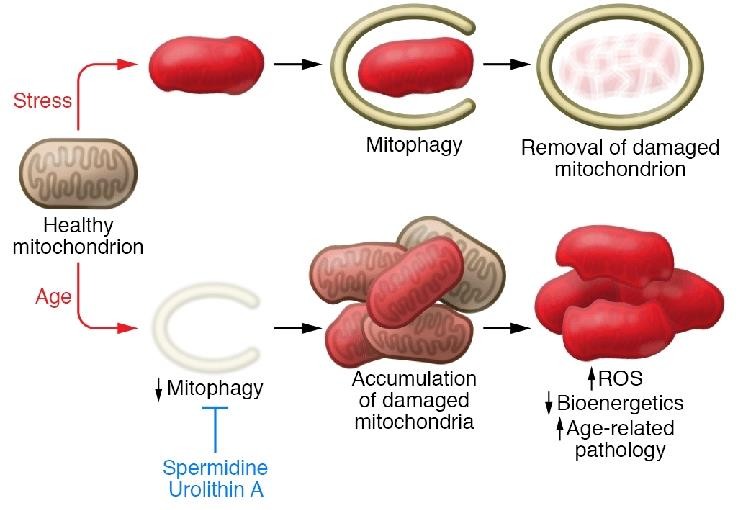
The next structure to discuss is the inner mitochondrial membrane. It is extensively folded and compartmentalized. The numerous invaginations of the membrane are called cristae. Which are separated by crista junctions from the inner boundary membrane juxtaposed to the outer membrane. Cristae significantly increases the total membrane surface area compared to a smooth inner membrane and thereby the available working space. The inner membrane is also loaded with proteins involved in electron transport and ATP synthesis. This membrane surrounds the mitochondrial matrix, where the citric acid cycle produces the electrons that travel from one protein complex to the next in the inner membrane. The crista membranes contain most, if not all, of the fully assembled complexes of the electron transport chain and the ATP synthase. The following illustration demonstrates this concept. We see the two membranes and subsequent ATP production. In review, at the inner mitochondrial membrane a high energy electron is passed along the electron transport chain. The energy released pumps hydrogen out of the matrix space. The gradient created by this drives hydrogen back through the membrane, through ATP synthase. As this happens, the enzymatic activity of ATP synthase synthesizes ATP from ADP. This whole process is called oxidative phosphorylation (OXPHOS), which is the main method and most efficient method the body uses to make ATP. The more efficient this process the better in shape one is.
Another structure present is the mitochondrial ribosomes. Mitochondrial ribosomes (mitoribosomes) perform protein synthesis inside mitochondria. Throughout evolution, mitoribosomes have become functionally specialized for synthesizing mitochondrial membrane proteins. Mitochondrial ribosomes resemble bacterial ribosomes and both bacteria and mitochondria ribosomes share a slightly different genetic code from that in the nucleus. Actually, we see that ribosomes have two parts, a large and a small subunit.
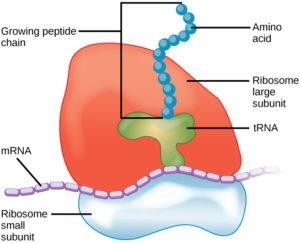
Although most DNA is packaged in chromosomes within the nucleus, mitochondria also have a small amount of their own DNA. This genetic material is known as mitochondrial DNA or mtDNA. Mitochondria are a trans-kingdom enigma. At the molecular level, the components of Human mitochondria are assembled from viruses, bacteria, and other organisms. As such, the organelle we see in human cells today is called trans-kingdom mixture that doesn’t fully resemble any of its ancestors.
The mitochondrial genome is built of 16,569 DNA base pairs, whereas the nuclear genome is made of 3.3 billion DNA base pairs. In keeping with its bacterial ancestry, mtDNA is also circular and multicopy with hundreds to thousands of copies present in every cell. mtDNA is very genetically compact and encodes only 13 proteins, all of which are core subunits of the oxidative phosphorylation (OXPHOS) complexes. These OXPHOS complexes, found only within mitochondria, are unique in human biology as they are the only cellular structures formed of proteins encoded by genes from the two separate genomes. The nuclear DNA provides around 90% of the required proteins for OXPHOS, and the mtDNA provides the remaining 10%. Remember that the OXPHOS complexes are responsible for ATP production. Mitochondria are the only organelle to have their own DNA. Mitochondrial DNA (mtDNA) is more susceptible to damage (including mutations) than nuclear DNA. The reason for this is many folds. Most likely this is due to a lack of histones to protect the DNA from damage. The below diagram gives a brief explanation of histones. Histones
package and order the DNA into structural units called nucleosomes. They act as spools around which the DNA gets coiled and thus a very long strand of DNA can be fit into a much smaller space. This is demonstrated in the following:
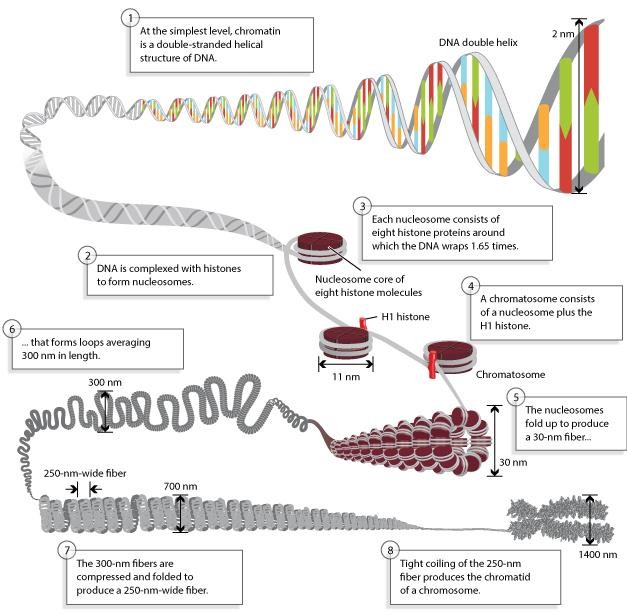
DNA damage is also caused by the proximity of mtDNA to Reactive Oxygen Species (ROS) production. We must remember that the mitochondria are engaged in oxidative phosphorylation which means that they are using oxygen to produce energy. The by-product of the energy production is the ROS. Also, mtDNA has limited DNA repair systems and limited proofreading capacity during replication all of which can lead to accumulated mitochondrial DNA damage. Furthermore, the mitochondrial DNA is ever changing. When a cell divides, its mitochondria are partitioned between the two daughter cells. However, the process of mitochondrial segregation occurs in a random manner and is much less organized than the highly accurate process involved in nuclear DNA division during cell replication commonly called cell mitosis. As a result, daughter cells receive similar, but not identical, copies of their mitochondrial DNA.
WHAT REGULATES THE MITOCHONDRIA? THE SIRTUIN FAMILY OF PROTEINS
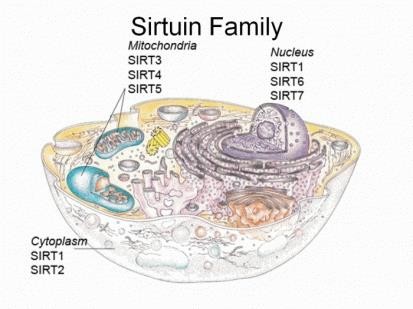
Sirtuins are a family of proteins that regulate cellular health. Sirtuins play a key role in regulating cellular homeostasis. Homeostasis involves keeping the cell in balance. Sirtuins can only function in the presence of NAD+, nicotinamide adenine dinucleotide, a coenzyme found in all living cells. NAD+ is vital to cellular metabolism and hundreds of other biological processes. Humans contain seven sirtuins (SIRT1-7) that modulate distinct metabolic and stress response pathways. Three sirtuins, SIRT3, SIRT4 and SIRT5, are located in the mitochondrion. The others are found in the nucleus and one in the cytoplasm. The basic role of sirtuins, however, is that they remove acetyl groups from other proteins. Acetyl groups control specific reactions. They are physical tags on proteins that other proteins recognize will react with them. Sirtuins work with acetyl groups by doing what’s called deacetylation. This means they recognize there’s an acetyl group on a molecule then remove the acetyl group, which tees up the molecule for its job. One way that sirtuins work is by removing acetyl groups (deacetylating) biological proteins such as histones. When the histones have an acetyl group, the chromatin is open, or unwound. When the histones are deacetylated by sirtuins, the chromatin is closed, or tightly and neatly wound, meaning gene expression is stopped, or silenced. This is not that common for the Sirtuins in the mitochondria.
Mitochondria regulation is where things get interesting. If we start manipulating the regulation of the mitochondria then there is a whole host of conditions from aging to chronic neuro-degenerative conditions which we might be able to impact. Recent findings have shed light on how the mitochondrial Sirtuin function in the control of basic mitochondrial biology, including energy production, metabolism, apoptosis, intracellular signaling and perhaps most importantly mitochondrial genesis. The following diagram shows some of these aspects.
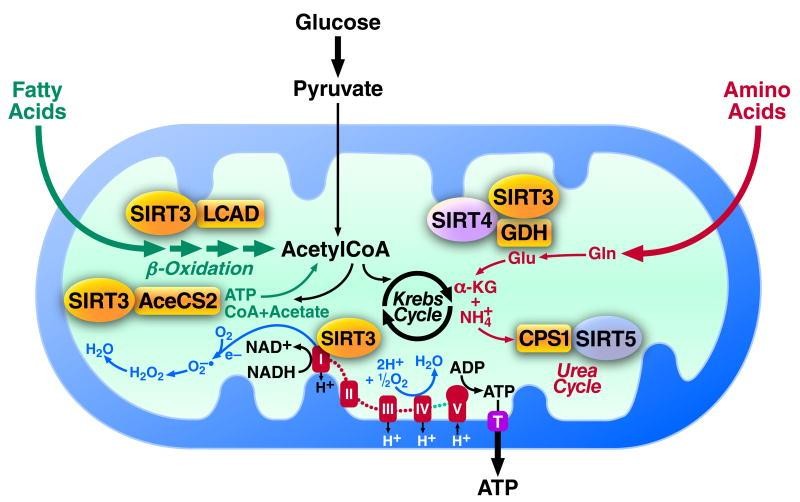
What these Sirtuins do is help in the generation of cellular energy. As high-energy electrons derived from glucose, amino acids or fatty acids fuels are passed through a series of protein complexes (I-IV), their energy is used to pump protons from the mitochondrial matrix through the inner membrane into the inner-membrane space. This is referred to as the electron transport chain. Ultimately, the electrons reduce oxygen to form water, and the protons flow down their gradient through ATP synthase, driving the formation of ATP from ADP. Reactive oxygen species (ROS) are a normal side-product of the respiration process. ROS are essentially free radicals. During cellular stress or damage, mitochondria release a variety of signals to the cytoplasm and the nucleus to alert the cell of changes in mitochondrial function. In response, the nucleus generates transcriptional changes (stimulates certain genes) to activate a stress response or repair the damage. The main function of mitochondria is to metabolize or break down carbohydrates and fatty acids in order to generate energy.
In review, ATP generation occurs within the mitochondrial matrix, though the initial steps of carbohydrate (glucose) metabolism occur outside the organelle. Glucose is first converted into pyruvate and then transported into the matrix. Fatty acids on the other hand, enter the mitochondria as is.
ATP is produced through the course of three linked steps. First, using enzymes present in the matrix, pyruvate and fatty acids are converted into a molecule known as acetyl-CoA. This then becomes the starting material for a second chemical reaction known as the citric acid cycle or Krebs Cycle. This step produces plenty of carbon dioxide and two additional molecules, NADH and FADH2, which are rich in electrons. The two molecules move to the inner mitochondrial membrane and begin the third step: oxidative phosphorylation. In this last chemical reaction, NADH and FADH2 donate their electrons to oxygen, which leads to conditions suitable for the formation of ATP. As an interesting aside, the optimal ratio of NAD+ /NADH is 700/1. Greater amounts of NADH lead to aging. NADH is considered a marker of aging.
A secondary function of mitochondria is to synthesize proteins for their own use. They work independently, and execute the transcription of DNA to RNA, and translation of RNA to amino acids (the building blocks of protein), without using any components of the cell.
Another aspect that the Sirtuins control is the control of Apoptosis. Apoptosis is a cellular process of programmed cell death. This occurs when the mitochondrial outer membrane allows much more permeability than normal. This will ultimately commit the cell to death. Mitochondrial sirtuins act in synergistic or antagonistic ways to promote respiratory function, antioxidant defense, insulin response and adipogenesis all of which can protect individuals from aging and aging-related metabolic abnormalities. If these cells are not dealt with they might become senescent cells. A senescent cell is one that should have died but continues to remain alive. The problem with the senescent cells is that they will release a number of inflammatory growth factors which can cause havoc in the body.
HOW DO WE KEEP OUR MITOCHONDRIA HEALTHY?
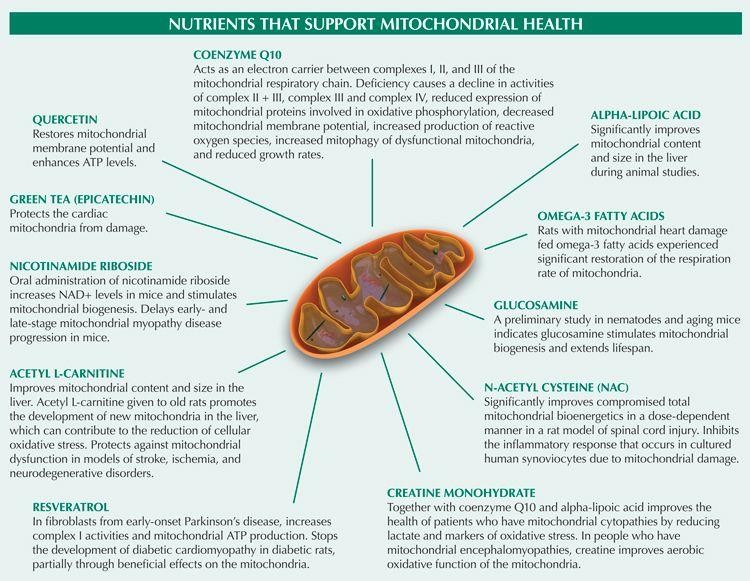
We have seen the ins and outs of the mitochondrial structure and function. The question that begs is how do we keep the mitochondria healthy? More and more research articles demonstrate the foundational importance of optimal mitochondrial function for health. There is growing body of research showing that mitochondrial dysfunction is surprisingly common and associated with most chronic diseases. The above and below illustrations give us an idea of how to keep our mitochondria running smoothly. The first illustration shows some supplements which keep things running smoothly.
The second illustration shows not only specific supplements but also classes of supplements such as polyphenols (Polyphenols are micronutrients that we get through certain plant-based foods) and proanthocyanins (these are chemical compounds that give the fruit or flowers of many plants their red, blue, or purple colors). It also stresses some life style factors that can increase mitochondrial efficiency. The specific supplements that enhance mitochondria function are evident in the list. Let us talk specifically about some of the polyphenols. They are included in many supplements, though they're also easy to get in your diet from foods like fruits, vegetables, teas, and spices. There are more than 8,000 types of polyphenols. A lack of polyphenols isn’t associated with specific side effects. However, they are regarded as “lifespan essentials” for their potential to reduce the risk of chronic diseases. This is especially true based on their effects on the mitochondria. Research suggests that supplementation with pyrroloquinoline quinone, also known as PQQ, can improve the number of mitochondria in the body while enhancing their functionality. This research also suggests that effective treatment for many diseases caused by mitochondrial dysfunction may rest at least partly in this coenzyme. PQQ is readily found in the soil, so it makes sense that the best dietary sources are fruits and vegetables grown in that soil. Fermented foods are rich in these molecules. One of the best sources of PQQ is very dark chocolate.
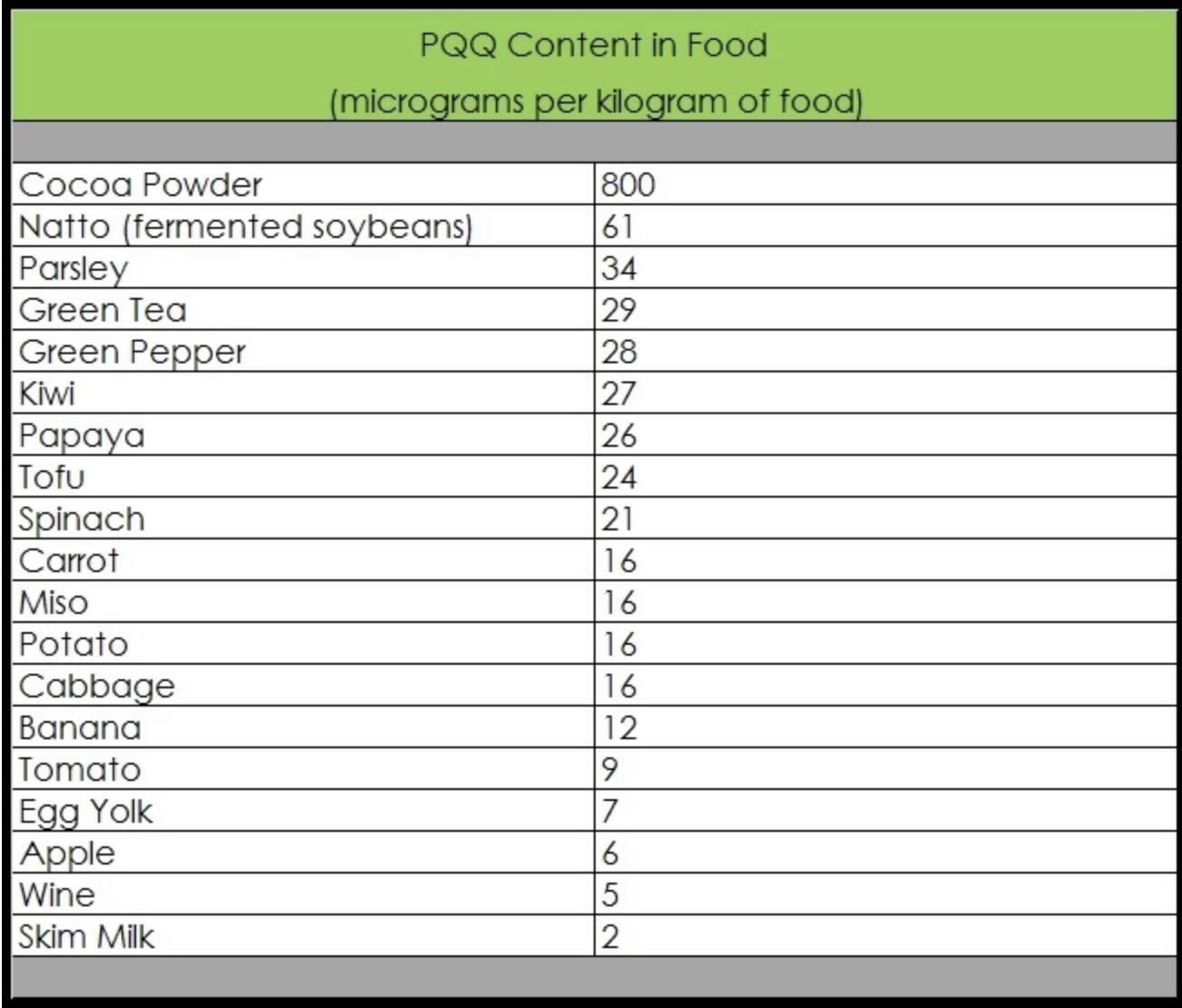
MITOCHONDRIAL PEPTIDES
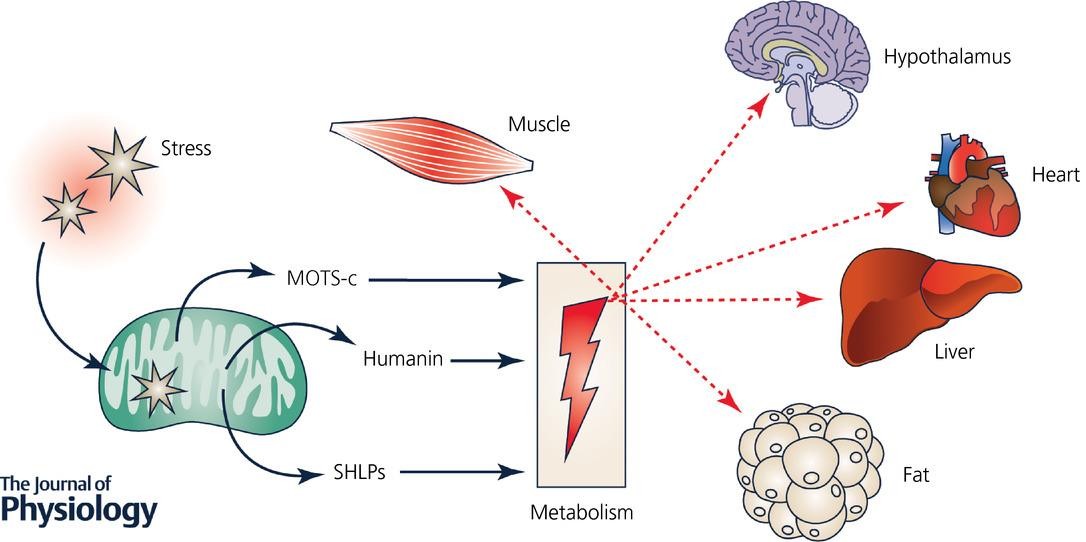
The above illustration shows some of the main peptides produced by the mitochondria. Mitochondria derived
peptides (MDPs) are a series of peptides encoded by mitochondrial DNA, and have similar functions to mitochondria. They are new metabolic regulators of human body, and play a cytoprotective role in maintaining mitochondrial function and cell viability under pressure. Peptides are biomolecules comprised of amino acids which play an important role in modulating many physiological processes in our body. Peptides are short strings of amino acids, typically comprising 2–50 amino acids. Amino acids are also the building blocks of proteins, but proteins contain more. Peptides may be easier for the body to absorb than proteins because they are smaller and more broken down than proteins.
Mitochondria produce numerous small polypeptides from their short open reading frame (sORF) regions of mtDNA that have significant biological activity. These include humanin, six small-humanin like peptides, and MOTS-c (mitochondrial open reading frame of the 12S rRNA type-c), together termed mitochondrial derived peptides (MDP). MOTS-c is a peptide which is called an exercise mimetic. Exercise Mimetics are novel ways of getting the benefits of exercising, without having to exercise. Multiple studies have demonstrated MOTSc's ability to enhance lipid beta-oxidation, increase thermogenic brown fat, decrease fat gain on a high-fat diet, and improve glucose uptake during glycolysis. Various mitochondrial peptides are produced but their use is not allowed in the USA under the current regulations. Hopefully, this will change with time.
As time goes on we are discovering more and more about the importance of the mitochondria and their ramifications to our health lifespan. We see that methods to boost mitochondria efficiency are varied. But when all is said and done. Some of the most important factors are exercise especially intermittent high intensity training, intermittent fasting, a variety of supplements including NAD. Low levels of oxidative stress such as is produced by intravenous ozone therapy are also important in the proper function of the mitochondria. We must remember that mitochondrial decay is inevitable it cannot be prevented at least with today’s technology. What is not inevitable is the rate of decay. The mitochondrial rate of decay is determined by one thing: oxygen efficiency. Perhaps the following diagram sums it all up:
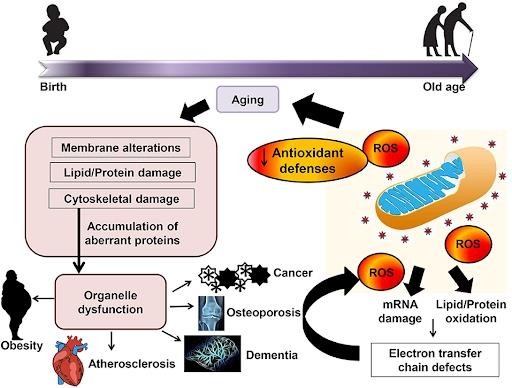
We see many bad things happen when our mitochondria are not working properly.
Mitochondria Structure Mitochondria have two membranes. The outer membrane covers the organelle and contains it. The inner membrane folds over many times. The folding increases the surface area inside the organelle. Many of the chemical reactions happen on the inner membrane of the mitochondria. The increased surface area allows the small organelle to do as much work as possible. Mitochondria numbers differ in cells as it depends on the job of that cell, e.g. muscle cells require a very large number of mitochondria whereas nerve cells require less.
- Dr. Purita
